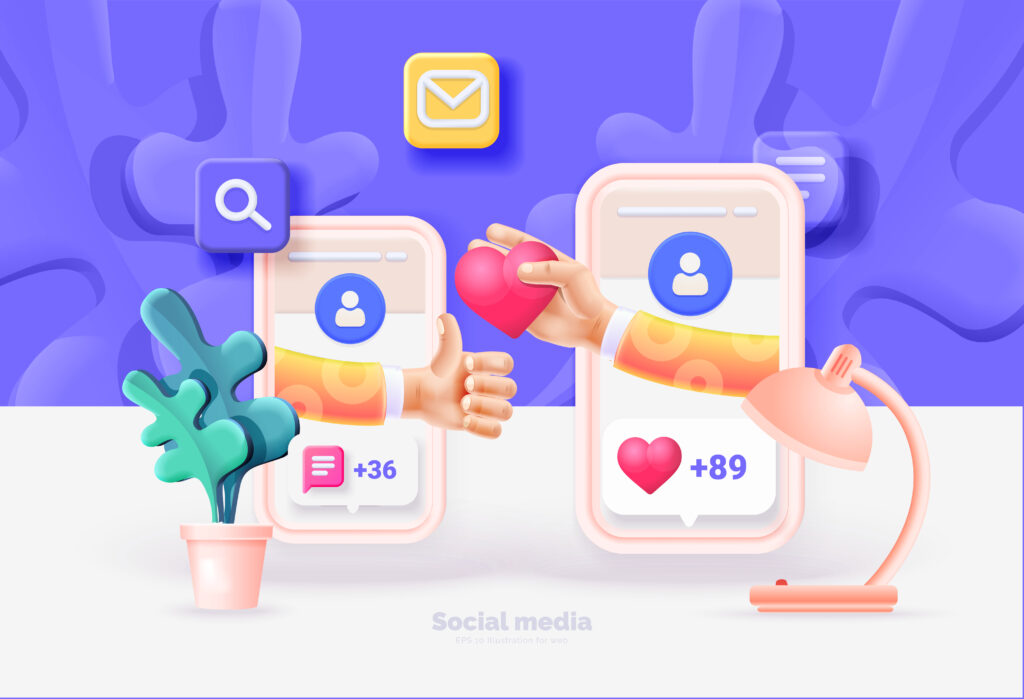It is not a secret that the field of digital marketing is rapidly changing due to advancements in technology and changes in consumer behavior, and as a result, digital marketers must stay up-to-date on the latest trends and best practices in order to be effective in their roles. This can include staying informed about new social media platforms, updates to search engine algorithms, and emerging technologies like artificial intelligence and machine learning. Additionally, it is important for digital marketers to be able to adapt their strategies and tactics in response to changes in the market and shifts in consumer preferences.
In this guide, we will inform you in a quite comprehensive way about the top 5 digital marketing trends that would dominate in 2023:
- Personalization and Customization: Using AI and Machine Learning to personalize and customize digital marketing campaigns for individual customers.
- Influencer Marketing: Partnering with social media influencers to promote products and services.
- Interactive Content: Using interactive content such as quizzes, polls, and games to engage with customers.
- Voice Search Optimization: Optimizing websites and content for voice search to improve visibility on smart speakers and virtual assistants.
- Micro-Moments: Creating targeted, timely, and relevant marketing campaigns that reach customers in micro-moments, such as when they are searching for information or ready to make a purchase.
1. Personalization and Customization
Personalization and customization in marketing refers to the use of technology such as AI and machine learning to tailor marketing messages, content, and experiences to individual customers. This can be done by analyzing customer data, such as browsing history, purchase history, and demographics, to create personalized recommendations, offers, and communications. Personalization can also be used to create customized landing pages, email campaigns, and social media ads. It helps to increase customer engagement and improve conversion rates. Companies can also use personalization to offer customized pricing, product recommendations, and loyalty programs. The ultimate goal of personalization is to create a more meaningful and relevant customer experience, leading to increased customer satisfaction and brand loyalty.
- Personalization and Customization Features:
Personalization and customization features in marketing refer to the use of specific information about a customer, such as their demographics, preferences, and behavior, to tailor marketing messages and offers to that individual. This can include things like personalized email campaigns, targeted advertisements, and customized product recommendations. The goal of personalization and customization is to make the customer feel valued and understood, and to increase the likelihood of them engaging with the brand and making a purchase.
- Personalization and Customization Best Practice
When it comes to personalization and customization, the best practice is to:
- Collect User Data: In order to personalize the experience, it’s important to gather data on the user’s preferences, behavior, and history.
- Use the Data to Create Personalized Experience: Use the collected data to tailor the content, products, or services to the individual user’s needs and preferences.
- Provide Options for Customization: Allow the user to further customize their experience by providing options such as color schemes, layouts, or font sizes.
- Test and Iterate: Regularly test and iterate on the personalization and customization options to ensure they are meeting the users’ needs and expectations.
- Be Transparent about Data Collection: Be transparent about the data you are collecting, how it will be used, and give users the ability to control their data and preferences.
- Respect User’s Privacy: Always respect users’ privacy by being compliant with data protection laws and regulations.
By following these best practices, you can provide a personalized and customized experience that will increase engagement and customer satisfaction.
- Personalization and Customization Benefits for Marketing
Personalization and customization in marketing can benefit businesses by:
- Improving Customer Engagement and Satisfaction: Personalized and customized marketing messages and offers are more likely to resonate with customers and increase their engagement with a brand.
- Increasing Conversion Rates: Personalized and customized marketing campaigns can help businesses increase their conversion rates by tailoring messages and offers to specific segments of their customer base.
- Improving Customer Retention: Personalized and customized marketing can help businesses build stronger relationships with their customers, leading to increased customer loyalty and retention.
- Enhancing Customer Data Collection: By collecting data on customer preferences and behavior, businesses can gain insights into their customers and use that information to improve their marketing efforts.
- Enhancing Ability to Target Specific Audience: Personalized and customized marketing allows businesses to target specific segments of their customer base, increasing the effectiveness of their marketing campaigns and reducing wasted marketing spend.

2. Influencer Marketing
Influencer marketing is a form of marketing where brands partner with individuals who have a large and engaged following on social media platforms, such as Instagram, TikTok, and YouTube. These individuals, known as influencers, promote the brand’s products or services to their followers through sponsored posts, videos, and other content. Influencer marketing can be a cost-effective way for brands to reach a large and engaged audience, as well as to leverage the influencer’s credibility and trust with their followers.
There are different types of influencers, such as micro-influencers, macro-influencers, and Nano-influencers, each with a different reach and audience. For example, micro-influencers have a smaller but highly engaged following, while macro-influencers have a larger following but may not be as engaged. Nano-influencers have a smaller following but they are more niche-specific which can be effective for specific products or services.
Influencer marketing can also include different forms of collaborations, such as product reviews, giveaways, brand ambassadorship, sponsored posts and paid collaborations. Companies can also use influencer marketing to increase brand awareness, generate leads, and drive sales. It is important to align the influencer’s message and audience with the company’s brand and target market to be successful.
- Influencer Marketing Best Practice
Influencer marketing best practices include:
- Identifying the right influencers for your brand and target audience.
- Clearly defining the goals and objectives of the campaign.
- Providing influencers with detailed guidelines and instructions.
- Clearly communicating with influencers and regularly monitoring the campaign.
- Measuring the success of the campaign by tracking key metrics such as engagement and conversions.
- Maintaining transparency and authenticity in the partnerships.
- Building long-term relationships with influencers for ongoing campaigns.
- Keeping yourself updated with FTC guidelines and industry standards for sponsored content.
- Influencer Marketing Advantages
Influencer marketing can have several advantages for businesses, including:
- Increased Brand Awareness: Partnering with influencers can help businesses increase their visibility and reach a wider audience, leading to greater brand awareness.
- Credibility and Trust: Influencers have built a reputation and relationship with their followers, this can help businesses to gain credibility and trust among their target audience.
- Cost-Effectiveness: Influencer marketing can be more cost-effective than traditional forms of advertising, as businesses typically pay influencers a flat fee or commission rather than paying for advertising space.
- Targeted Audience Reach: Influencer marketing allows businesses to target specific demographics and interest groups that align with their products or services.
- Authenticity: Influencer marketing can provide a sense of authenticity to the brand, as the influencer’s followers already trust them and their endorsement.
- Better Performance: Influencer marketing has been shown to have better performance than traditional forms of advertising, as it often leads to higher engagement and conversion rates.

3. Interactive Content
Interactive content refers to digital or online media that allows users to engage and interact with the content in some way, rather than simply consuming it passively. Examples of interactive content include quizzes, polls, surveys, games, and interactive videos. The goal of interactive content is to increase engagement and participation, and to make the content more memorable and effective in achieving its intended purpose.
- Interactive Content Features:
Interactive content features refer to elements within digital content that allow for user engagement and interaction. These can include buttons, forms, polls, quizzes, games, and simulations, among others. Examples of interactive content include interactive infographics, interactive videos, and interactive landing pages.
- Interactive Content Best Practice:
When creating interactive content, it is important to keep the user engaged and interested. This can be achieved by:
- Making the content visually appealing and easy to navigate
- Keeping the content concise and to the point
- Incorporating a variety of interactive elements, such as quizzes, polls, and videos
- Allowing the user to personalize the content to their interests or needs
- Providing clear calls to action, such as signing up for a newsletter or purchasing a product
- Testing the content on different devices and in different browsers to ensure it is accessible to as many users as possible.
- Regularly updating and refreshing the content to keep it current and relevant.
It is also important to measure the success of your interactive content through metrics such as engagement, conversion rates, and feedback from users. This can help inform future improvements and adjustments to the content.
- Interactive Content Benefits
Marketing by increasing engagement and building deeper connections with audiences. It can also help generate leads, improve SEO, and provide valuable insights into customer preferences and behavior. Examples of interactive content include quizzes, polls, surveys, interactive infographics, and games.

4. Voice Search Optimization
Voice search optimization is the process of optimizing a website and its content to improve its visibility and ranking in voice search results. With the increasing popularity of virtual assistants and smart speakers, more and more people are using voice commands to search the internet, making it important for businesses to optimize their website for voice search.
Voice search optimization involves a combination of techniques to improve a website’s visibility and ranking in voice search results. These techniques include using long-tail keywords, structured data, natural language processing, location-based keywords, featured snippets, mobile optimization and answering questions.
Voice search optimization also includes creating content that is easily understandable and can be read out by voice assistants, as well as providing accurate, concise and relevant information to match the user’s intent and question.
Overall, Voice search optimization is a way to help ensure that your website and its content will be easily discoverable by people who are using voice search to find information online.
- Voice Search Optimization Features
Voice search optimization features include:
- Long-Tail Keywords: These are more conversational and natural-sounding phrases that people use when speaking, as opposed to short, typed queries. For example, “What is the best Italian restaurant in the city?”
- Structured Data: Utilizing structured data such as schema markup, to help search engines understand the content on your website and improve its visibility in voice search results.
- Natural Language Processing: Creating content that uses natural language and addresses the user’s intent, helps search engines understand the context of the query and match it with the most relevant results.
- Location-Based Keywords: Optimizing for location-based keywords, such as the name of a city or neighborhood, can help improve visibility for local voice search queries.
- Featured Snippets: Optimizing your content to be featured in the ‘position zero’ or featured snippet, which is a highlighted result that appears at the top of the search results page, increases the chances of your content being read out by the voice assistant.
- Optimizing for Mobile: Since voice searches are often done on mobile devices, optimizing your website for mobile is essential for improving visibility in voice search results.
- Optimizing for “Near Me” Queries: As more and more people are searching for things that are nearby, optimizing for “near me” queries is important for voice search optimization.
- Answering Questions: Voice assistants are most likely to read out answers from websites that provide clear and concise answers to a user’s query.
- Voice Search Optimization Best Practice
Best practices for voice search optimization include:
- Use Schema Markup: Use schema markup to help search engines understand the content on your website and improve its visibility in voice search results.
- Create Content that Answers Questions: Create content that answers common questions related to your industry, this will help match user’s intent and increase the chances of your content being read out by voice assistants.
- Monitor and Track Performance: Use analytics tools to track how your website is performing in voice search results and make adjustments accordingly.
- Test and Optimize for Different Virtual Assistants: As different virtual assistants may have different capabilities, it is important to test and optimize your content for the most popular virtual assistants.
By following these best practices, you can help ensure that your website and its content are easily discoverable by people using voice search to find information online.
- Voice Search Optimization Advantages
Voice search optimization has several advantages, including:
- Increased Convenience for Users: Voice search allows users to quickly and easily find the information they need without having to type out their query.
- Improved Mobile Accessibility: Voice search is especially useful for mobile users, as it allows them to search for information hands-free.
- Better Natural Language Understanding: Voice search algorithms are designed to understand natural language, which can result in more accurate search results for users.
- Greater Potential for Personalization: Voice search can be used to gather more information about the user, which can be used to personalize their search results.
- New Opportunities for Businesses: Companies can optimize their website and content for voice search to reach potential customers through smart speakers and virtual assistants.
- Micro-Moments
Micro-moments are brief instances in which consumers turn to their devices for quick information or inspiration. These moments are characterized by their immediacy and context, and they often have a high level of intent behind them. Examples of micro-moments include searching for a nearby restaurant on a smartphone, looking up the weather forecast on a tablet, or watching a product video on a laptop. Companies can use micro-moments as opportunities to connect with consumers and provide them with the information or inspiration they are looking for.
- Micro-Moments Characteristics
Micro-moments can play a significant role in a company’s marketing strategy by providing opportunities to connect with consumers in real-time and provide them with relevant information and inspiration. Some key features of micro-moments in marketing include:
- Immediacy: Micro-moments are characterized by their immediacy, as consumers turn to their devices in search of quick information or inspiration. Marketers can capitalize on this by providing timely and relevant content or offers.
- High Intent: Micro-moments often have a high level of intent behind them, as consumers are actively seeking out information or inspiration. Marketers can use this to their advantage by providing personalized and relevant content that meets the specific needs of the consumer.
- Contextual Relevance: Micro-moments are also characterized by their context, as consumers often turn to their devices in specific situations or locations. Marketers can use this information to provide location-based offers or contextually relevant content.
- Mobile Optimization: Many micro-moments take place on mobile devices, so it’s important for marketers to optimize their campaigns for mobile to ensure that they can reach consumers where they are.
- Omnichannel: Consumers move across different channels and devices in micro-moments and Marketers can use this to their advantage by providing a seamless and consistent experience across all channels.
- Personalization: Micro-moments provide an opportunity for marketers to personalize their message and offers, as they can use data and insights to understand the specific needs and interests of the consumer.
- Micro-Moments Best Practice
There are several best practices that companies can follow to effectively capitalize on micro-moments in their marketing strategy:
- Understand Consumer Intent: It’s important for companies to understand the intent behind consumer’s micro-moments so that they can provide relevant and timely information or inspiration.
- Optimize for Mobile: As many micro-moments take place on mobile devices, it’s important for companies to optimize their campaigns for mobile to ensure that they can reach consumers where they are.
- Use Data and Insights: Companies can use data and insights to understand consumer behavior and tailor their marketing efforts to meet the specific needs and interests of the consumer.
- Be Present across Channels: Consumers move across different channels and devices during micro-moments, so companies should be present across all channels to provide a seamless and consistent experience.
- Be Quick and Concise: Micro-moments are brief, so companies should be quick and concise in their messaging to capture consumer attention.
- Be Contextually Relevant: Companies should be aware of the context of the micro-moment, such as the consumer’s location or the time of day, and provide contextually relevant information or offers.
- Personalize the Message: Companies can use data and insights to personalize their message and offers, making them more relevant and effective.
- Measure and optimize: It’s important to measure the performance of micro-moment campaigns, and use the data to optimize future efforts.
- Micro-Moments Advantages
Micro-moments can provide several advantages for companies in their marketing strategy:
- Increased Engagement: By providing relevant and timely information or inspiration, companies can increase engagement with consumers during micro-moments.
- Increased Conversions: By providing personalized and contextually relevant information or offers, companies can increase the likelihood of conversions during micro-moments.
- Better Targeting: Companies can use data and insights to understand consumer behavior and tailor their marketing efforts to meet the specific needs and interests of the consumer.
- Increased Brand Awareness: By being present across different channels and devices during micro-moments, companies can increase brand awareness and reach new audiences.
- Improved Customer Experience: By providing a seamless and consistent experience across all channels, companies can improve the customer experience and build loyalty.
- Better ROI: By effectively capitalizing on micro-moments, companies can see a better return on investment from their marketing efforts.
- Increased Mobile Optimization: By optimizing the content and campaigns for mobile, companies can reach more customers at the time when they are looking for information.
- Real-Time Optimization: Companies can use the data and insights from micro-moment campaigns to optimize their marketing efforts in real-time, leading to more effective results.
As a final point, these may be the most predicted 5 top trends to control marketing in 2023, but this does not decrease or eliminate the role of the other marketing strategies that would work side-by-side with these trends to maximize the benefits of digital marketing.





